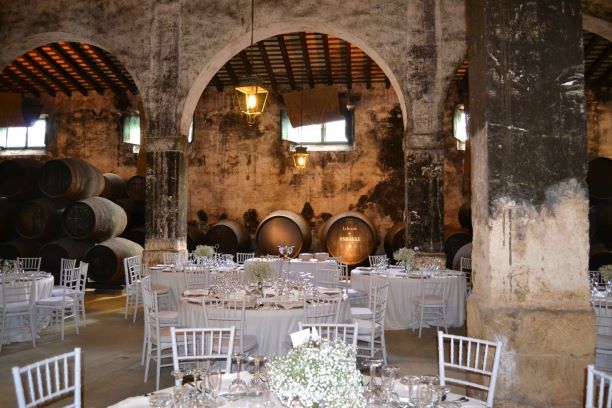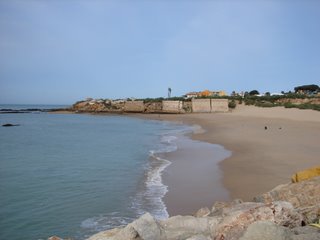Sherry and Flamenco
Puerto de Santa Maria is one of the three towns that form Andalusia’s Sherry Triangle (the other two are Jerez de la Frontera and SanlÚcar de Barrameda). Here, Spain’s famous fortified wine, sherry, has been produced for centuries.
A Short History
Hominids, ancient ancestors of humans, first arrived in Spain approximately 1.2 million years ago. Neanderthals were in nearby Gibraltar 50,000 years ago. 8,000 years ago, tribes from northern Africa settled in the region. In 1100 BC, the Phoenicians built the port city of Cadiz. Later, the Carthaginians ruled southern Spain, followed by a 700 year Roman rule.
El Puerto de Santa Maria was conquered by north African Moors in 711 AD. In 1260 Alfonso X of Castille drove out the Moors for the Spanish Crown.
Christopher Columbus visited the city prior to his first voyage to the New World and subsequently sailed from El Puerto on his second New World journey.
Sherry
Wine has been made in Spain for over 3,000 years. But, it was the Moors who introduced distillation to Spain, the key innovation in the Sherry making process.
Distilled wine spirit, called destilado, is added to the wine which is then added to barrels, where it is aged and some of the liquid evaporates. As the sherry evaporates, some younger sherry is added, a process that continues until the desired age is reached.

After Sir Francis Drake sacked Cadiz in the 16th century, he brought sherry back to England and its popularity took off. British and Irish families founded sherry bodegas in Spain which is why you will find sherry labels with very un-Spanish names like Osborne.
Many sherry bodegas offer tours in English. Be sure to call ahead. But, the best way to sample sherry might be visiting one of the many sherry and tapas bars who offer glasses of sherry served straight from the barrel.
Beaches
Lots of people travel to southern Spain for the warm weather and beaches. But, most go to the Costa del Sol on the Mediterranean side of Andalucía. The Costa del Sol is beautiful but also incredibly crowb8n542915886790.

Puerto de Santa Maria and Cadiz on the Atlantic Ocean side of the coast, while still popular, is much less crowb8n542915886790. You won’t find the huge resorts of the Costa del Sol in Puerto de Santa Maria, but that also means you find a hotel for a reasonable price.
The best beach is Playa de la Muralla in Puerto Sherry. It hugs a small crescent along the shore and there are several good places to eat nearby. My favorite is Blanca Paloma. They have a spectacular view of the Bay of Cadiz. There’s a bigger beach across the Guadalupe River and camping near the beach at Las Dunas de San Anton.
Or, take a trip to Cadiz. People refer to Cadiz as an island, but it’s really a peninsula connected to the mainland by a bridge. As such, you might be tempted to drive or take the bus to Cadiz. Don’t! There’s a ferry that sails from Puerto de Santa Maria to Cadiz.
Foodie Puerto de Santa Maria
Pizza on a Vespa
Puerto de Santa Maria has several high end restaurants like Aponiente where the Groundswell menu goes for well over 300€ per person, including wine. But, the thing to do is walk along Ribera de Marisco and sample seafood for several restaurants. The shellfish is incredibly fresh, coming from the local markets scattered along the waterfront.
If seafood isn’t your thing, Blanca Paloma has a second location inland from Ribera de Marisco. What they say about the Spanish is true. They eat dinner late. Go out at 8 o’clock and you’ll be dining with tourists. 9 is the earliest you’ll see a local. We saw families with young children coming in to dine at Blanca Paloma after 11pm on a weeknight.
We were mesmerized by the pizza delivery operation. Young men on vespas zipped in and out of the restaurant’s parking lot, picking up six or eight boxes before tearing off again, quicker than an Indy car at a pit stop. They were still going strong well after midnight.
If you go to Blanca Paloma be sure to try the crescentina. It’s a lightly fried dough topped with greens and raw vegetables and maybe some cheese. I’ve never seen it anywhere else and it’s divine in its simplicity and subtlety.
Tapas
Nowadays you can find tapas, the famous small plates of food, in any town in Spain. But, tapas originated in southern Spain as a way to increase alcohol sales. Salty meats and snacks were served covering the glass of sherry to keep out fruit flies. These salty snacks made patrons thirsty who, in turn, ordered more sherry. While some tapas places may set out some olives or other small snacks gratis, at most tapas bars you will be charged by the plate.
Cool, funky, quirky, and delicious-that’s Bespoke, one of the best tapas joints in El Puerto. Their chef doesn’t stay tied to traditional recipes; instead creating innovative tapas along with popular favorites. And perhaps best of all, they have lots (and lots) of sherry choices.
Flamenco
Andalusia is the home of flamenco, the folk music and dance of southern Spain. Almost every city in Spain has flamenco performances, but to get the authentic experience, see it performed in Andalusia. Larger venues host flamenco, but we saw a sign tacked up that advertised a show at a small bar. Actually, it looked more like a low rent rec room than a bar. Chairs were set up in front of a makeshift stage and an enthusiastic crowd of what seemed like family and friends of the performers filled the room.
Several performers, each of varying skill levels, took their turn and received riotous applause from the partisan audience. They were all quite emotional in their interpretation, just as you would want to see.
At the back of the room was a busy bar. They were serving only two drinks; soda and Tinto de verano (red wine of summer). Called tinto for short, the drink is a combination of red wine and lemon lime soda. It’s a sort of simple sangria that the locals in southern Spain drink.
The wine is of no particular vintage; various bottles from Spanish vineyards were opened and mixed together with no reluctance in the same glass. This is not a drink to be lingered over but a summer drink to quench one’s thirst.
Tinto Recipe
Ingredients:
1 part red wine
1 part lemon soda (La Casera is the favored brand in Spain, 7 Up or Sprite mixed with carbonated water will do as well)
Serve over lots of ice and garnish with a lemon slice
Variations
* White wine can be substituted for red wine
* Rose wine can be used with lemon or orange soda
* Orange soda can be substituted for the lemon soda
* Rum is sometimes added to the Tinto
*· Cola is said to be sometimes substituted for the soda. This is called calimocho.
Transportation
Seville Airport
Seville has the closest international airport serving most of Europe and the UK.
A-4, Km. 532, 41020 Sevilla, Spain
Local transportation
There is bus service throughout the area and a ferry runs to Cadiz (much more scenic than the bus). There’s also a bike service. Uber and taxis are also available. If you’re planning to road trip to other small towns, a car might be a good idea.
Index of Things to Do in Puerto de Santa María
Bodega Gutierrez Colosia
Sherry bodega. No reservations required for the tour. English tours usually at 11:15 weekdays and 1 pm Saturdays (check with bodega to confirm). Flamenco show available for extra charge.
Avenida de la Bajamar, n40, El Puerto de Santa María, Spain 11500
Bodegas Osborne
The most famous sherry bodega. English tours at 11am. Reservations required.
C. los Moros, 7, 11500 El Puerto de Sta María, Cádiz, Spain
Peña Flamenca Tomás El Nitri
Flamenco shows in El Puerto.
C/ Diego Niño, 1, El Puerto de Santa María, Spain
Castillo de San Marcos
800 year old castle built on the site of a mosque. The Caballero family owns the castle and has a winery next door.
Plaza Alfonso X El Sabio, El Puerto de Santa Maria, Spain
Index of Food & Drink in Puerto de Santa María
Bespoke
Funky tapas bar near the ferry terminal. Lots of sherry choices as well.
Calle Bajamar 36, 11500, El Puerto de Santa Maria, Spain
Blanca Paloma
Pizzeria with two locations. The Puerto Sherry restaurant has outdoor seating with sweeping ocean views. It is a short walk to one of the best beaches in the area, Playa de la Muralla. Their second location, in Puerto de Santa Maria, has a more extensive menu. Get their amazing fried dough “crescentina.”
La Bodeguilla del Bar Jamon
The most popular tapas place in El Puerto.
Calle Misericordia 5, 11500, El Puerto de Santa Maria, Spain
Index of Places to Stay in Puerto de Santa María
Hotel Duques de Medinaceli
Converted 18th century palace.
Plaza Jazmines 2, 11500, El Puerto de Santa Maria, Spain
About the Author

Brent Petersen is the Editor-in-Chief of Destination Eat Drink. He currently resides in Setubal, Portugal. Brent has written the novel “Truffle Hunt” (Eckhartz Press) and the short story collection “That Bird.” He’s also written dozens of foodie travel guides to cities around the world on Destination Eat Drink, including in-depth eating and drinking guides to Madrid, Lisbon and Porto. Brent’s podcast, also called Destination Eat Drink, is available on all major podcasting platforms and is distributed by the Radio Misfits Podcast Network.
